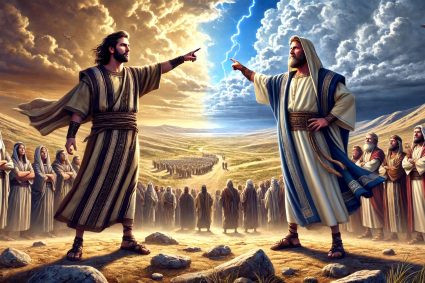


7.3 The Mountain and the Multitude
The Transfiguration: A Glimpse of Jesus’ Glory and the Coming Kingdom
Read Mark 9:1–13. What did Peter, James, and John see one night with Jesus?
In Mark 9:1–13, Peter, James, and John experience something extraordinary: they see Jesus in His divine glory, transfigured on a high mountain, speaking with Moses and Elijah. This vision is a powerful revelation of the coming Kingdom of God in its power—a fulfillment of Jesus’ promise that some of His disciples would see the Kingdom of God come with power before they tasted death.
The Transfiguration provides the disciples with a profound insight into the divine nature of Jesus, linking His forthcoming suffering and death with His future glory. It is a moment of encouragement and hope, especially in light of the upcoming challenges the disciples would face following Jesus’ crucifixion. The presence of Moses and Elijah, two major figures from the Old Testament, indicates that Jesus is the fulfillment of the Law and the Prophets, and that His path to the cross is part of the divine plan.
However, this peak spiritual revelation is soon met by the reality and challenges of daily life as Jesus and the three disciples descend the mountain. Upon returning, they encounter a crowd, including the remaining disciples who are unable to heal a possessed boy. This stark contrast between the heavenly glory on the mountain and human weakness below highlights the discrepancy between faith and doubt.
The desperate cry of the boy’s father—“I believe; help my unbelief!”—captures the tension between faith and doubt that many of us experience in our daily lives. This account reminds us that true discipleship encompasses both moments of divine revelation and everyday struggles. The journey of faith involves highs and lows, moments of deep spiritual insight and challenges that test our beliefs.
The experience on the mountain teaches us that the glory and Kingdom of God are present even in our world, despite being surrounded by doubt and chaos. It calls us to, like the boy’s father, direct our faith towards Jesus despite all doubts and to trust in His power and mercy. In the highs and lows of our own faith journeys, we can trust that Jesus is with us—in His glory and in our need.
In what situations have you had to cry out, “I believe, help my unbelief”? What have you learned from these experiences?
The cry “I believe, help my unbelief” is a deeply personal expression of the tension between trust and doubt that we encounter in difficult moments. In my own life, there have been situations where I have felt or even spoken these words out loud.
One such situation occurred when I faced a significant decision that would greatly impact my life. I felt that God was leading me in a particular direction, but the uncertainty and fear of the potential consequences were overwhelming. In these moments, my faith felt weak, and I was torn between trusting God’s plan and doubting my ability to follow it.
I cried out internally for God’s help because I knew my own faith was insufficient to overcome my fear and doubt. This prayer was both an acknowledgment of my faith and an admission of my weakness. It was a moment of deep dependence on God, recognizing that true faith does not mean the absence of doubt but trusting in God’s faithfulness despite it.
From this experience, I learned that faith often grows in the tension between trust and doubt. These words—“I believe, help my unbelief”—remind us that it is okay to have doubts as long as we bring them to God and trust in His help. I also learned that God responds to our honest wrestling with faith. He is ready to meet us where we are and strengthen our faith, even when it is weak and uncertain.
These experiences have encouraged me to persevere in faith, even when it is difficult, and have helped me understand more deeply that faith is a process that grows through challenges and doubts. God is patient with us and helps us when we call out to Him in our weakness.
The story of Jesus’ Transfiguration on the mountain and the subsequent experience of the disciples in the valley offers valuable lessons for our daily lives and faith. These events highlight that our spiritual lives involve both peaks and valleys and that the path of discipleship traverses these fluctuations.
-
Encouragement from Spiritual Highs: The Transfiguration was a moment of deep revelation and encouragement for the disciples. In our own lives, we sometimes experience similar “mountain-top moments” where we feel God’s presence and glory intensely. These moments strengthen our faith and give us the power to face daily challenges. It is important to consciously experience these spiritual highs and use them as a source of strength and hope when encountering difficulties later on.
-
Faith in Daily Life: After the Transfiguration, Jesus and the disciples return to everyday reality, where they face challenges that test their faith. This shows us that faith is not only tested in the highs but especially in the everyday struggles—when doubts and difficulties arise. Like the father of the possessed boy, we often have to cry out, “I believe, help my unbelief!” This tension between faith and doubt is a part of our daily spiritual journey.
-
God’s Presence in Times of Need: The Transfiguration reminds us that Jesus is with us in moments of glory as well as in times of need. Even when we feel overwhelmed by doubts and difficulties, it is important to remember that God is with us, even in the darkest times. This understanding helps us to trust in God’s faithfulness, even when we cannot clearly see or understand Him.
-
Growth through Challenges: The story demonstrates that our faith often grows through challenges. Doubts and difficulties are not the end but opportunities to deepen our faith and become stronger. By bringing our weaknesses and doubts before God, we can experience how He strengthens us and guides us through these times.
In summary, this story teaches us that the Christian life is a journey through both moments of revelation and trials. In these fluctuations, there is an opportunity to deepen our faith by holding on to God’s presence and faithfulness in both the highs and lows. It is a reminder that true faith is not the absence of challenges but the trust that God carries us through every situation.
Only those who climb the mountain can understand the crowd with a clear view.
(Visited 14 times, 1 visits today)






















